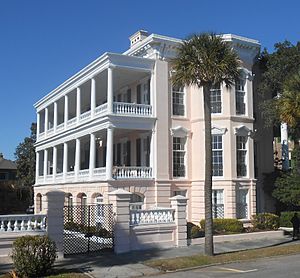St. Julien Ravenel facts for kids
Quick facts for kids
St. Julien Ravenel
|
|
|---|---|
| Born | December 15, 1819 Charleston, South Carolina, US
|
| Died | March 16, 1882 (aged 62) Charleston, South Carolina, US
|
| Resting place | Magnolia Cemetery |
| Nationality | American |
| Occupation | Physician, chemist |
| Spouse(s) | Harriott Horry Rutledge |
| Children | 9 |
St. Julien Ravenel (born December 15, 1819 – died March 16, 1882) was an American doctor and a scientist who studied chemicals, especially for farming.
During the American Civil War, he helped design a special boat called the torpedo boat CSS David. This boat was used to attack a Union warship called USS New Ironsides. After the war, he became a leader in using fertilizers to help crops grow better. He also helped the phosphate fertilizer industry grow in Charleston, South Carolina.
Early Life and Studies
St. Julien Ravenel was born in Charleston, South Carolina. He was the oldest child of John Ravenel, who was a merchant and ship owner, and his wife Anna Eliza Ford. He went to schools in Charleston and then continued his education in Morristown, New Jersey.
In 1840, he finished his medical studies at the Medical College in Charleston. He then studied more in Philadelphia and for a year in Paris, France. When he came back to Charleston, he started working as a doctor. He also became a teacher of anatomy at the Medical College.
St. Julien Ravenel didn't really enjoy being a doctor. He started working with Professor Louis Agassiz, studying tiny things under a microscope, nature, and how living things work. In 1850, when a big science group called the American Association for the Advancement of Science met in Charleston, Dr. Ravenel was in charge of their money.
On March 20, 1851, he married Harriott Horry Rutledge. She was a writer and historian. Between 1852 and 1872, St. Julien and Harriott had nine children together.
In 1852, St. Julien started studying chemistry. But he didn't completely stop his medical work. In 1855, when an illness called Yellow Fever spread in Norfolk, Virginia, he was one of the first people to help. He worked hard to care for the sick during that time.
At his farm, Stony Landing Plantation, he experimented with making lime. He used a natural material called marl found along the Cooper River. Later, he found cement under the lime layers. In 1856, he teamed up with Clement H. Stevens to start the Colleton Lime Works at his farm. This company sold lime for 90 cents a barrel. This company provided most of the lime used by the southern states during the American Civil War.
During the Civil War
When the Civil War started in 1861, Dr. Ravenel joined the Phoenix rifles as a private soldier. He served during the attack on Fort Sumter. After that, he became a surgeon (a doctor for soldiers) with the 24th South Carolina infantry. The next year, he was put in charge of a Confederate Hospital in Columbia, South Carolina. Soldiers from Virginia and other places were treated there.
The Northern navy was blocking the South's ports, making it hard for ships to get in or out. To fight this, people came up with the idea of a torpedo boat. In 1863, the first special torpedo boat was designed and built near Charleston. Dr. Ravenel created the first design for this boat. It was built with help from David C. Ebaugh.
The boat was named the David. It was shaped like a cigar and could partly go underwater. It had a torpedo attached to a 14-foot iron pole at the front. The plan was to drive this steam-powered boat into an enemy ship and make the torpedo explode against its side. On October 5, 1863, the CSS David attacked the USS New Ironsides near Charleston Harbor. It caused some damage but didn't sink the ship.
Dr. Ravenel's knowledge of chemistry was very useful. He was put in charge of a laboratory in Columbia, South Carolina. This lab made almost all the medical supplies for the South, including medicines. When General Sherman's army got close, the lab was moved to North Carolina. His wife, Harriott, stayed behind and saw the Union army arrive and the city burn.
After the War
Before the war, Dr. Ravenel had started trying out chemistry to improve farming. He continued his experiments in 1866. He found that using phosphate of lime helped crops grow much better. For example, he was able to increase the amount of cotton grown on one part of his farm from 100–150 pounds per acre to 300–400 pounds.
In August 1867, Ravenel and N. A. Pratt found a large amount of this mineral at Lambs, South Carolina. Because of this discovery, he helped start a company called Wando Phosphate Company, which made fertilizers. Over time, this led to a growing fertilizer industry that helped South Carolina's economy recover after the war.
For the rest of his career, he worked as a chemist for bigger phosphate companies. He helped create easier ways to make fertilizer. He also found a way to grow a lot of short grain and hay on the sandy coast of South Carolina. Another important thing he did was drill artesian wells in the Charleston area. These wells provided water for local factories. Because of this, he is known as the "father of Charleston's artesian well system."
St. Julien Ravenel passed away on March 15, 1882, due to a liver illness. He was survived by his wife, four sons, and five daughters.
His wife, Harriott, wrote under the pen name H. Hilton Broom. She won a Charleston newspaper prize for her 1879 novel Ashurst. She later published other books, including Eliza Pinckney (1896), The Life and Times of William Lowndes of South Carolina (1901), and Charleston, the Place and the People (1906).


